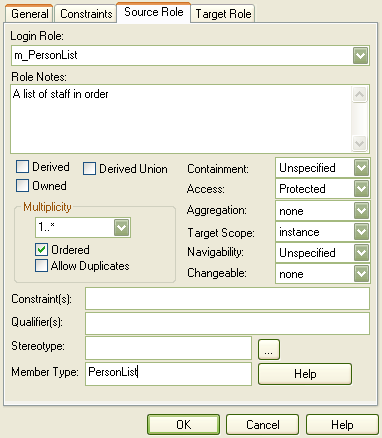This description refers to the role of the Source element in a relationship, but applies equally to the role of the Target element.
A link can have certain properties assigned to one end, and be associated with the particular role that element plays in the relationship. You can enter details about this role to further develop your model.
Set Source Role Details
To set the source role details, follow the steps below:
| 1. | Double-click on a connector. The Connection Properties dialog displays. |
| 2. | Select the Source Role tab. |
| 3. | Enter the required details and click on the OK button. |
Field |
Description |
||||||||
<Type> Role |
Type the name of the role to be played. |
||||||||
Role Notes |
Type any required notes about the role. |
||||||||
Derived Union |
Select this checkbox if the role value or values can be computed from other information. |
||||||||
Owned |
Select this checkbox if the role is owned by the opposite class as opposed to the association. |
||||||||
Derived Union |
Select this checkbox if the role is derived from the properties that subset it. |
||||||||
Multiplicity |
Type a value, or click on the drop-down arrow and select the role multiplicity. (You can define the values of this field on the Cardinality tab of the UML Types dialog.) This is the range of instances of the role that can be active in the relationship; for example, one employee can be assigned to tasks; for the target role you define the range of instances (e.g. tasks) the employee could be assigned to. The values have the following formats:
Note that you can also define source and target element multiplicity in the element Attribute properties. |
||||||||
Ordered |
Select this checkbox if the role is a list and the list is ordered. |
||||||||
Allow Duplicates |
Select this checkbox if the role can contain duplicate elements (relevant only if multiplicity is > 1). |
||||||||
Containment |
Select the nature of the containment at the Destination (reference, value...). |
||||||||
Access |
Select the access level for the role. |
||||||||
Aggregation |
Select the type of aggregation that this role uses. |
||||||||
Target Scope |
Select the level at which this role applies (instance or classifier). |
||||||||
Navigability |
Select whether or not this role is navigable (non-navigable ends are shown depending on diagram properties). |
||||||||
Changeable |
Select whether this role is subject to change. |
||||||||
Constraints |
Type any constraint on the role. |
||||||||
Qualifier |
Type any qualifiers or restrictions on the role. Separate multiple qualifiers with a semi-colon. |
||||||||
Stereotype |
Type or select any stereotype that applies to this end of the association. |
||||||||
Member Type |
Type a role type that can be used when generating collection classes for multiplicity > 1. |
Note: Source role details are displayed at the start end of a connector. If you have drawn the link the wrong way, you can always use the Reverse Direction menu option from the connector context menu.


